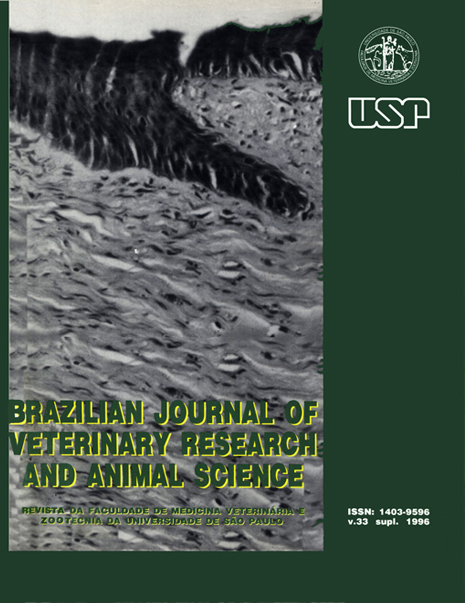Some nutritional and metabolic aspects of calves maintained under two different dietary protein and experimentally infected with Haemonchus placei
DOI:
https://doi.org/10.11606/issn.2318-3659.v33isupl.p295-301Keywords:
Calves, Haemonbhus\ Dietary protein D, Digestibility, Nitrogen balance, Water balance.Abstract
The experiment was carried out to study the effects of the dietary protein and the infection with H. placei on nutritional parameters in six-months-old calves, based on their response to an infection of 100,000 infective larvae. Treatments consisted of two protein levels, 97.8 (G1) and 175.3 (G2) g of crude protein per kg of dry matter. After three monthsreceiving the diet, the animals were infected. Five days prior and 30 d after infection, animals were kept in metabolic cages to measure diet digestibility, water and N balance. Thirty-five days after infection, animals were slaughtered, abomasum removed and the worm burdens counted. There were no statistical differences in live weight changes, but
animals from G1 showed a tendency to decrease weight after infection. The protein level in diet showed an effect (p < 0.01) on plasma, urea and protein. The infection affected (p < 0.05) haematocrit, haemoglobin, albumin and total plasma protein. Crude protein digestibility was lower (p < 0.05) in G1. Dry matter and crude protein digestibilities were
not affected by infection. Nitrogen balance was lower for G1 and urine nitrogen excretion was increased (p < 0.01) by infection. There was no effect on water balance. It is suggested that some of the nutritive parameters studied were affected by protein level in diet, as well as by the infection with H. placei.
Downloads
Downloads
Published
1996-12-03
Issue
Section
ANIMAL PATHOLOGY
License
The journal content is authorized under the Creative Commons BY-NC-SA license (summary of the license: https://
How to Cite
1.
Abdalla AL, Gennari SM, Vitti DMSS, Meirelles CF, TakahashI S. Some nutritional and metabolic aspects of calves maintained under two different dietary protein and experimentally infected with Haemonchus placei. Braz. J. Vet. Res. Anim. Sci. [Internet]. 1996 Dec. 3 [cited 2025 Apr. 5];33(supl.):295-301. Available from: https://www.revistas.usp.br/bjvras/article/view/50215





